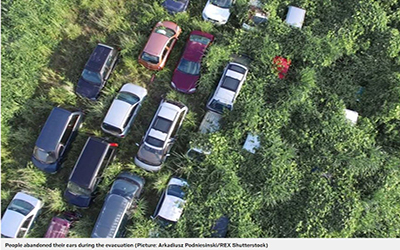TLDR: there are many innovations affecting real estate these days, but the ones we are currently using in our homes and offices won’t intrinsically change the market or the product. It will more likely be current innovations in adjacent industries which disrupt how we’ve used our homes and offices for the past century.
I research and think a lot about when real estate, or more generally any built environment will fall to a major disruption, like Netflix to Blockbuster or AirBnB with the hotel industry (to a degree) or WeWork to a traditional office lease approach. When thinking about these trends of innovation, we need to consider the different types of innovation and try to watch those which might evolve into something truly disruptive. Its an over used word in business and tech circles, but it is characteristic of the reality we are seeing with increasing frequency in most industries. As Marc Andreessen has said “software is eating the world” — if your company isn’t a tech company (ie. any company which is integrating technology into its core business model can be a technology company) then you might not be around in 5 or 10 years.
From the popular book “Innovators Dilemma”, Innovations fall into two general categories: sustaining innovation and disruptive innovation. Sustaining innovation can be thought of as iterative improvements on products being created. An example of a sustaining innovation in real estate today might be increasing the efficiency of the HVAC system or designing a home to function with IoT devices and home AI such as Amazon’s Alexa. These are novel improvements, but aren’t going to drastically alter the industry or how we use a built environment. A disruptive innovation is a little more complex. It often starts in more entry level market segments, falls off the radar of incumbent businesses, but moves up market quickly (indeed, faster than the incumbents do with their iterative approach to improvement) eating up the market of those focusing on the traditional product.
Netflix is a great example here. As the famous last words of the then Blockbuster CEO said “I’ve been frankly confused by this fascination that everybody has with Netflix …Netflix doesn’t really have or do anything that we can’t or don’t already do ourselves.” Netflix started with an inferior product (mail order to your house DVDs with a poor selection) and once established and worked out the kinks, quickly moved upmarket to take over that industry. The same Blockbuster CEO also turned down the purchase of Netflix for $50M…Netflix is now valued at over $80B.
Lets consider a few innovations that we are starting to see more frequently today that might affect various real estate products and markets:
Internet of Things (IoT) appliances and electronics. This is when your light switch can talk to your phone, and your phone can also look inside when fridge when you’re not at home, and you can lock, unlock and view your home from your smart phone app. IoT stands for “Internet of Things” and generally describes the connectivity of traditionally “dumb” appliances to the internet, allowing the user greater control of the appliances and further control when not at home. While this is a huge growth segment which will see much convenience added, I am not so certain that anything offered here will truly change the industry or the use of homes, offices, etc. I am more certain that we’ll look back and wonder why we didn’t always have cool gadgets like the camera doorbell, however!
Home AI assistants are pretty handy, but in some ways are a glorified smart phone (Siri has been able to answer questions, order things, etc since its release in 2011) or online shopping cart. The Amazon Echo, Google Home and others largely act as statically located smart phones. They can connect to many IoT devices/appliances, order you food, order on Amazon, play music or podcasts, and other helpful interactions. Again, these are handy and are of increasing popularity, but aren’t revolutionizing home or office use.
Smart thermostats are a variation of IoT to a degree. Connecting your thermostat online allows you to control functionality from a smart phone app and generally allows for a greater depth of heating and cooling analysis. When should you turn down the temp? Turn it up? Many smart thermostats offer learning algorithms so that it can map the behavior in your home and cater the heating and cooling settings to your needs. Useful and probably going to be every thermostat in the next 2 years, the smart thermostat also doesn’t offer a vast upgrade to our homes or office spaces.
VR and AR are interesting solutions which are primarily being used in entertainment sectors at the moment. VR stands for virtual reality where the user, generally wearing a headset, is placed in a fully digital/virtual environment. Everything they see and interact with is graphically rendered. AR stands for Augmented Reality and generally renders digital elements within our real physical environments. While the uses are extensive in the video entertainment and gaming segments, an interesting use case with growing prevalence is viewing homes or offices from a distance, or before they are constructed. Built environments have long been rendered in three dimensions with architects and for project planning and design, so it wasn’t a huge stretch to beautifully render these and offer people the ability to view a home, virtually, from a great distance (different country) or to show someone what the home or office they are designing should look like in the future. This is a great use of the technology which I’d wager that will be used ubiquitously in real estate marketing in less than 5 years.
While these entertaining, and to some degree educating uses are visually educating, they won’t represent massive changes. But, I do believe AR and possibly VR will, in other ways, vastly change how we use the office space. More and more people are able to work from home, at least part of the time, commuting in to work for meetings and such. Well, what if you could be placed in that meeting from wherever you were, and the experience was close to actually being physically present? If virtual meetings were able to bridge the digital/human gap and make our telecommuting more connected and human then this will have massive impacts on office use. Performing administrative tasks at office will be all but extinct, and office use will be reserved for creative, high-EQ needs.
This could be disruptive.Ride sharing isn’t frequently thought of in terms of how it will alter real estate, but it should be. All of our modern cities have been shaped, almost exclusively, around the use of cars. With ride sharing hitting massive exponential adoption, we need to start considering how it will affect the shape of our cities, how we interact with our cities and neighborhoods, and parking! One concern to many smart growth enthusiasts is that ride sharing may remove an extensive amount of burden from commuters. Ride sharing significantly cuts the cost of commuting, and with future AI-driven vehicles, we will be able to work, sleep or be entertained for the duration of a commute.
Given this, there may in fact be a greater push away from city cores to outlying areas where housing prices are more affordable. Parking is another interesting consideration. On a slightly longer term horizon, many cars will be owned by ride sharing companies and piloted by an AI. This vehicle will continuously drive throughout the day, eliminating the huge waste of space of a car sitting unused some 95% of the day in your garage or office parking lot. This will free up considerable tracts of valuable land in urban and suburban locations alike, not to mention the additional uses garages could see for ground oriented dwellings. Big changes here — this in my view is a significant change which over the next decade will completely reform how we built — and use — our cities.
Prefab construction techniques are nothing new, but seem to be of increasing prevalence. I suspect there are certain technologies that are maturing to a place where prefabricated manufacturing facilities can be increasingly automated which drives efficacy and allows reduced resource use. Indeed, some jurisdictions such as Singapore require or enforce PPVC construction techniques. These and related technologies are one of my greatest hopes of bringing housing affordability more in line with median earnings in North America. Government intervention hasn’t shown much empirical improvement for affordability in any market, any where, and while I regard myself as a tech-optimist, this area does bear huge potential to drive down waste, time to construct, and cost (from a labor standpoint) of construction. If this guy can do back flips, why cant he be programmed to use a hammer! Imagine a work with with a dozen of these guys working 24/7…
Love to hear your thoughts, comments and predictions on where we should be watching incoming technologies and how they will affect real estate development and construction!






